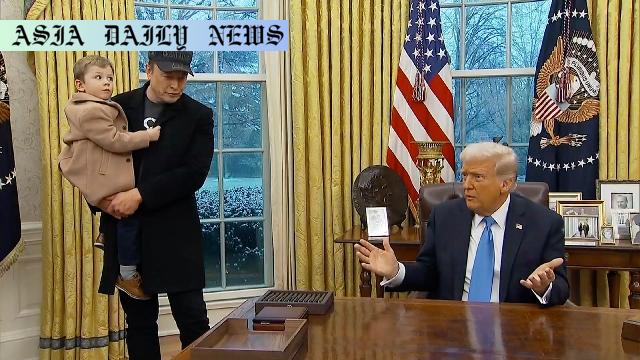Workforce cuts: US President Trump orders federal agencies to drastically reduce staff using a 4:1 hiring rule, exempting safety roles.
US President Trump has signed an executive order mandating federal workforce reductions.
A 4:1 hiring rule will be implemented, exempting public and law enforcement safety roles.
The Department of Government Efficiency (DOGE) leads the reform, aiming to reduce corruption and waste.

Introduction
The Trump administration has initiated a bold and sweeping reform to the federal workforce through a new executive order signed by President Donald Trump. This directive mandates a significant reduction in federal employees while prioritizing governmental efficiency. The order introduces a 4:1 hiring rule, which means that for every four employees leaving a federal agency, only one replacement can be hired. Government agencies will now be working closely with the Department of Government Efficiency (DOGE) to implement this reform effectively.
The Purpose Behind the Reduction
President Trump emphasized the need for this directive during an address in the Oval Office, citing rampant inefficiencies within federal institutions. Trump stated that his administration has uncovered “billions of dollars” in waste, fraud, and abuse. By implementing these changes, the administration aims to “weed out corruption” and minimize redundancy across departments, thus improving overall productivity.
Exemptions and Priorities
While the new policy is rigorous, it does include specific exemptions for roles related to public safety, immigration enforcement, and law enforcement. Moreover, military personnel are not subject to this workforce reduction plan. This exemption ensures that essential services tied to the well-being and security of the public remain unaffected during the transition period brought about by the reform.
DOGE’s Role in Workforce Reductions
The Department of Government Efficiency will play a pivotal role in this reform as agencies must consult with their DOGE team leads before making any new career appointments. Elon Musk, the director of DOGE, expressed his support for the move, noting that the public’s demand for major government reforms would now be met.
Targeted Institutions and Controversy
Initial efforts by DOGE had already impacted several government institutions, including the U.S. Agency for International Development, before the executive order was announced. These actions sparked intense debate and legal challenges, as critics argue that such drastic measures could undermine the federal government’s effectiveness and paralyze essential programs.
Potential Benefits
Proponents of the workforce cuts highlight the potential for substantial budgetary savings and increased efficiency in governance. By reducing excessive staffing levels, resources can be redirected towards critical areas requiring funding. Supporters believe this move aligns with conservative fiscal policy, emphasizing smaller government and minimal interference in economic activities.
Criticism and Concerns
Opposition to the executive order has been strong, with critics warning about the long-term implications, including possible erosion of public sector services. Furthermore, unions representing federal employees have expressed concerns about worker rights, increased workloads, and reduced job security. Legal experts have also questioned the constitutionality of delegating such influential roles to the DOGE without Congressional oversight.
Future Outlook
The implementation of this order signifies a monumental shift in the structure and priorities of the federal government. However, the road ahead may involve further legal battles, operational challenges, and varying public responses. All eyes will be on DOGE and federal agencies as they navigate this unprecedented reform.
Conclusion
The 4:1 workforce cuts mandated by President Trump have sparked a national conversation on the balance between efficient governance and the need for robust public services. While the reforms promise benefits such as reduced corruption and waste, critics continue to raise concerns about their practical execution and potential downsides. Only time will determine whether this bold move will deliver the intended outcomes.



Commentary
The Controversial Restructuring of Federal Workforces
The executive order signed by President Trump serves as one of the most ambitious undertakings in modern governance. By mandating workforce reductions through a 4:1 hiring policy, the administration is sending a clear message about its goals for cost-cutting and prioritizing efficiency. Proponents of the directive might rightly highlight the need for accountability in federal spending and the potential to eliminate redundant roles. However, with reforms of this magnitude, the risks warrant equal examination. Could we be sacrificing long-term institutional reliability for short-term savings?
Impacts on Public Services
The exemptions for safety and enforcement roles reflect sensible foresight, ensuring vital public services remain unaffected. However, the burden being placed on other agencies may create operational inefficiencies over time. For instance, overburdened staff in understaffed agencies could lead to errors, delays, and perhaps even a decline in service quality. Government workers’ unions have raised understandable concerns about workload escalation as well.
A Need for Balance
Leadership within DOGE will undoubtedly play a crucial role in navigating these challenges. Elon Musk’s statement about responding to public demands for reform reflects a strong mandate for change, but it is imperative that these reforms are carried out thoughtfully. Whether this directive ultimately benefits or harms the federal system depends on striking the right balance between efficiency and the ability to deliver services effectively.